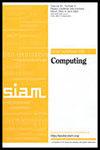寻找多个终端之间的最大边不相交路径
IF 1.6
3区 计算机科学
Q3 COMPUTER SCIENCE, THEORY & METHODS
引用次数: 0
摘要
本文章由计算机程序翻译,如有差异,请以英文原文为准。
Finding Maximum Edge-Disjoint Paths Between Multiple Terminals
Let $G=(V,E)$ be a multigraph with a set $T\subseteq V$ of terminals. A path in $G$ is called a $T$-path if its ends are distinct vertices in $T$ and no internal vertices belong to $T$. In 1978, Mader showed a characterization of the maximum number of edge-disjoint $T$-paths. In this paper, we provide a combinatorial, deterministic algorithm for finding the maximum number of edge-disjoint $T$-paths. The algorithm adopts an augmenting path approach. More specifically, we utilize a new concept of short augmenting walks in auxiliary labeled graphs to capture a possible augmentation of the number of edge-disjoint $T$-paths. To design a search procedure for a short augmenting walk, we introduce blossoms analogously to the matching algorithm of Edmonds (1965). When the search procedure terminates without finding a short augmenting walk, the algorithm provides a certificate for the optimality of the current edge-disjoint $T$-paths. From this certificate, one can obtain the Edmonds--Gallai type decomposition introduced by Seb\H{o} and Szeg\H{o} (2004). The algorithm runs in $O(|E|^2)$ time, which is much faster than the best known deterministic algorithm based on a reduction to linear matroid parity. We also present a strongly polynomial algorithm for the maximum integer free multiflow problem, which asks for a nonnegative integer combination of $T$-paths maximizing the sum of the coefficients subject to capacity constraints on the edges.
求助全文
通过发布文献求助,成功后即可免费获取论文全文。
去求助
来源期刊

SIAM Journal on Computing
工程技术-计算机:理论方法
CiteScore
4.60
自引率
0.00%
发文量
68
审稿时长
6-12 weeks
期刊介绍:
The SIAM Journal on Computing aims to provide coverage of the most significant work going on in the mathematical and formal aspects of computer science and nonnumerical computing. Submissions must be clearly written and make a significant technical contribution. Topics include but are not limited to analysis and design of algorithms, algorithmic game theory, data structures, computational complexity, computational algebra, computational aspects of combinatorics and graph theory, computational biology, computational geometry, computational robotics, the mathematical aspects of programming languages, artificial intelligence, computational learning, databases, information retrieval, cryptography, networks, distributed computing, parallel algorithms, and computer architecture.
 求助内容:
求助内容: 应助结果提醒方式:
应助结果提醒方式:


